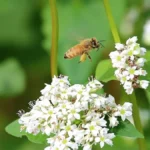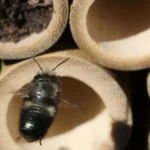What are the best wildflowers for honey bees? You can plant a lot of flowers that are good for bees – not only will these help honeybees, but they will also help your solitary bees. Let us have a look at some tried and tested favorites.
A Quick Look At What Flowers Do For Bees
If we look at a beehive in full strength, it will have 50-60 000 bees in it. In warm weather about half of these can be the field force, leaving and collecting nectar. The remaining half stays back in the hive and does hive work. Sometimes this number can be a bit greater.
Let us work on some simple assumptions. The average bee makes about 15 flights a day. She visits about 100-200 flowers per flight. That means that she visits 1500 to 3000 flowers a day. A field force of one hive visits 45 to 90 million flowers a day. Honeybees are impressive pollinators.
This means a single beehive needs 45-90 million flowers a day to keep occupied. If you plant wildflowers in a 200 square foot flower bed, and these flowers have a density of 30 flowers per square foot (rosemary, borage, basil) you will have 6000 flowers, or just enough to fully occupy two honeybees for a day!!
Let’s look at how we can crank these numbers up and make a difference to the pollinator populations in our gardens by planting wildflowers for bees.
Planting Wildflowers For Bees
When we plant wildflowers for bees we need to look at the scale of the planting. If we are planting wildflowers for honeybees, we can make a small difference to the bees by planting the right plants. But we can make a big difference to ourselves by enjoying watching the bees.
When we plant wildflowers for bees, if we do so for solitary bees, we can make a much bigger difference for solitary bees. In this article, I will provide advice on how you can plant flowers for honeybees (for you), for honeybees (for bees – ie lots of flowers), and for wild solitary pollinators.
Planting Wildflowers For You To Enjoy Watching Bees
Bee watching is great fun! I have spent hundreds of hours (quite a few paid) enjoying watching bees on flowers. They get so into their little jobs, burrowing into the flowers. Watching them comb the pollen off their heads and eyes, pack it into their corbicula (pollen baskets) and then fly back to the hive is great fun.
Flowers such as perennial basil, borage, rosemary, and catnip are my favorites to attract clouds of all sorts of bee
Perrenial basil and catnip both support large populations of solitary bees as well as a few honeybees per plant. When we choose flowers to plant for solitary bees and to enjoy watching honeybees visit, we need to choose plants that flower for long periods of time or produce huge numbers of flowers.
Buckwheat
Ok, you want to plant flowers specifically for honeybees. And you want to make a difference to a few hives. You need to ask “What is the most attractive flower to bees?” The answer to this is that there is no one correct answer. But Buckwheat is a lovely plant to plant in a bee meadow.
If you have a patch of buckwheat that is say 50 yards long and 20 yards wide, you can plant buckwheat and at the same time plant a bee wildflower meadow.

Buckwheat grows very quickly and dies after a month and a half or so in my experience. It will however create an incredible pulse of nectar. Even a small patch of buckwheat can actually make a difference to a beehive. An acre of buckwheat can help one hive produce over 150lb of honey.
Perrenial Basil and Rosemary
These are amazing plants. The best way to grow these plants is to source them from somebody that has a plant. In colder areas, grow your mother plants in pots and move them indoors to overwinter. My area has 5-10 winter frosts and every few years we get a black frost.
The black frost will kill perennial basil but not rosemary, the normal frosts just trim it. I always overwinter a few basil “mothers” in my greenhouse. In a colder climate, you may want to overwinter your perennial basil and rosemary indoors. Use lights to keep them happy. Sunlight is best, but in winter the sunlight is a bit pathetic, so supplemental gro lights help.
Cloning
Towards the end of winter cut cuttings from your mother basil plants. You can root them out in a cloning chamber. Luckily the boom in cannabis cultivation around the world has made these chambers cheap and easy to buy. Cut the cuttings just below a leaf node. Scratch the stem of the cutting where you want roots to form. I use a knife to gently scratch the stem.
Here we see the cutting of clones from the mother plant. Then the making of holes, dipping stems in cloning powder (or gel) then inserting clones. Note how I trimmed the leaves on the clones to reduce the amount of water the stems lose before they get roots.
Dip the stem in cloning gel. This gel encourages rapid root formation. Stick the stem in a small pot filled with herb soil. You will see many people suggest using coco coir to start cuttings – I personally find I get much better results using soil formulated for herbs. I mix my own soils, but if I could buy that above soil I would do so. It is a good blend of all the things a small basil plant needs.


The completed cuttings in the cloning chamber. Note how I adjust the air vents to being just a sliver open so that humidity in the chamber remains high. This allows the cuttings to have minimal stress and root well.
Once you have put the plants in the seed tray, sprinkle them with water and cover them with the cloning lid. I normally adjust the air holes in the top so that there is a bare minimum of airflow in and out.
Planting Out In Spring
Once your cloned perennial basil and rosemary plants are rooted, plant them out after the last major frosts are past. If there is a small risk of frost you can cover the plants with a cloche. I personally have never bought such a thing – I just go to the local coffee shop and they get their beans in clear gallon plastic buckets – I use these to cover the plants.
The perennial basil grows very fast and once it starts to flower it will attract all manner of pollinators to its beautiful long purple flowers. Harvest the leaves from the plants heavily, cutting off the growth buds – this encourages the plant to grow more growth shoots, and more growth shoots equal more flowers and more bees. It also means you have an endless supply of basil and rosemary to use on everything. Which is never a bad thing.
Solitary Bee Nests
Once you have planted your bee meadows and flower patches do not forget to create nesting sites for solitary bees. We have a few articles on this already.
Here is a nice little video of some skittish solitary bees, honeybees, and butterflies on my basil plants. I counted 8 different pollinator species in under a minute of observation on my bee-friendly wildflowers!!
I hope this article has helped you work out how to plant the best wildflowers for honey bees. And of course for solitary bees! It is so much fun having a little patch of pollinator chaos in your garden with lovely bee wildflowers – I often go out and watch the bees starting the day on my basil plants. It gives me hours of satisfaction watching the solitary bees, carpenter bees, and all sorts of other weird things buzzing around. I normally do this when I have to take long work calls. If you enjoyed this please share!!
Read more about: Wildflower Meadow Instead Of A Lawn
FAQs
What are the best wildflowers for honey bees?
Honey bees love wildflowers like buckwheat, clover, borage, lavender, and perennial basil. These plants provide abundant nectar and pollen that support bee colonies year-round.
Why are wildflowers important for honey bees?
Wildflowers offer a diverse range of nectar sources and help maintain bee health. The variety in wildflowers helps honey bees build strong hives and enhances honey production.
When is the best time to plant wildflowers for honey bees?
The best time to plant wildflowers for honey bees is in early spring, after the last frost, to ensure they bloom during the prime foraging season.
Which wildflowers produce the most nectar for honey bees?
Flowers like borage, clover, sunflowers, and goldenrod are particularly nectar-rich, making them ideal for feeding honey bees and increasing honey production.
Can I plant wildflowers for bees in small gardens or urban spaces?
Yes! Even small gardens or urban areas can support honey bees by planting wildflowers like lavender, basil, and rosemary in pots or flower beds.
How do wildflowers benefit both honey bees and solitary bees?
Wildflowers provide nectar and pollen for honey bees, while also creating habitat and food for solitary bees, which are essential pollinators for local ecosystems.
Do wildflowers help increase honey production?
Yes, wildflowers can increase honey production by providing consistent nectar sources for bees, especially varieties like buckwheat and clover which are known for enhancing honey yields.
What wildflowers attract the most pollinators besides honey bees?
Wildflowers like lavender, echinacea, and sunflowers attract a wide range of pollinators, including honey bees, bumblebees, butterflies, and solitary bees.
How should I care for wildflowers to maximize their benefit to honey bees?
Regular watering and deadheading flowers can prolong blooming periods, ensuring that honey bees have access to nectar and pollen throughout the season.
Can wildflower meadows replace lawns for better honey bee support?
Yes, transforming lawns into wildflower meadows provides bees with ample food and creates a bee-friendly habitat, which is beneficial for biodiversity and honeybee populations.

Dr. Garth A. Cambray is a Canadian/South African entrepreneur and beekeeper with 28 years of experience in apiculture and specializes in adding value to honey. His Ph.D. research developed a new advanced continuous fermentation method for making mead that has resulted in a number of companies globally being able to access markets for mead. His company, Makana Meadery, exports honey mead to the USA where it is available to discerning connoisseurs. He has also developed technologies to commercially manufacture organic honey vinegar in Zambia for export globally. He holds a few patents globally in the ethanol industry and believes in technology and knowledge transfer for human development and environmental sustainability. One of his proudest achievements is the fact that the wind farm he started at one of his old apiary sites has essentially made his hometown carbon neutral.










